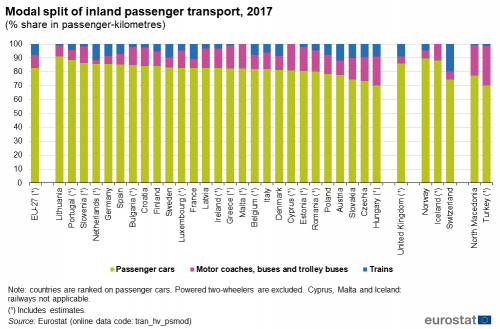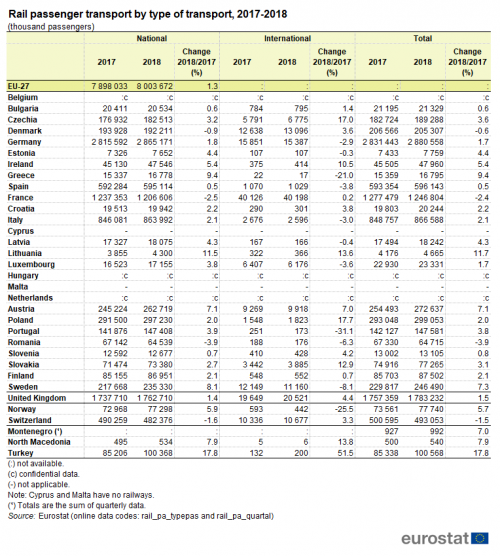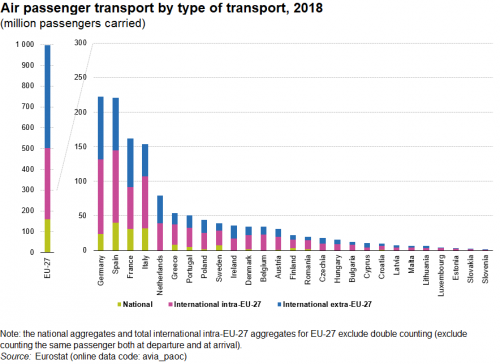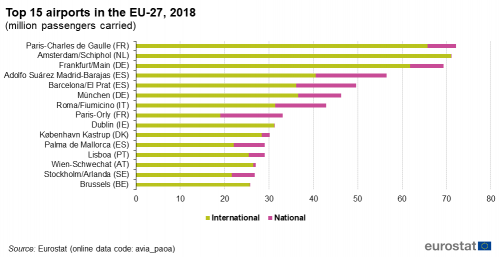Archive:Passenger transport statistics
This Statistics Explained article is outdated and has been archived - for recent articles on structural business statistics see here.
Data extracted in July 2020.
Planned article update: July 2021.
Highlights
This article provides details on the current situation and recent developments for passenger transport statistics within the European Union (EU-27), based on the most recent data available. It presents information on passenger transport by a range of transport modes, such as road, rail, air and maritime transport. Among these, the principal mode of passenger transport is the passenger car, fuelled by a desire for greater mobility and flexibility. However, the high reliance on the passenger car as a means of transport across the EU-27 has contributed to increased congestion and pollution in many urban areas and on many major transport arteries.
Full article
Modal split of inland passengers
TEST
See the interactive map of imports of crude oil to EU countries by origin.
Tool 1: Energy trade visualisation
Source: Eurostat (nrg_ti_oil)
TEST
Figure 1 shows that passenger cars accounted for 82.9 % of inland passenger transport in the EU-27 in 2017, with motor coaches, buses and trolley buses (9.4 %) and passenger trains (7.8 %) both accounting for less than a tenth of all traffic (measured in passenger-kilometres).

(% share in passenger-kilometres)
Source: Eurostat (tran_hv_psmod)
The passenger car was by far the most predominant mode for passenger transport in all EU-27 Member States. In Lithuania, passenger cars accounted for 91 % of all passenger transport in 2017. Slovakia, Czechia and Hungary were the only EU-27 Member States where the shares of passenger cars were below three quarters. For Hungary, this was reflected in the highest share of motor coaches and buses (21.1 %) among the EU-27 Member States. An even higher share was reported for the candidate countries Turkey (28.2 %) and North Macedonia (22.2 %). The lowest share for motor coaches, buses and trolley buses was in the Netherlands (2.9 %). The EU-27 Member States with the highest share of passenger transport by train were Austria (11.9 %) and the Netherlands (11.4 %). However, this was well below the EFTA country Switzerland, where trains carried out 19.7 % of all passenger transport in 2017. At the same time, their share was less than 2.0 % in Slovenia, Lithuania and Greece, as well as in the candidate countries North Macedonia and Turkey.
Rail passengers
Concerning rail transport, 8 billion passengers travelled on national railway networks in the EU in 2018 (Table 1). It has to be noted that international transport represented less than 8 % of the total rail passenger transport for all countries except Luxembourg where it represented 26 %. All in all, 19 of the EU-27 Member States reported increases ─ and three reported decreases ─ in the total number of passengers transported between 2017 and 2018 (Cyprus and Malta have no railways, and for Belgium, Hungary and the Netherlands the data is confidential). The largest increases were recorded in Lithuania (+11.7 %), Greece (+9.4 %), Sweden (+7.3 %) and Austria (+7.1 %). The candidate country Turkey also rose substantially (+17.8 %). By contrast, the transport of passengers decreased by 3.9 % in Romania and 2.4 % in France.

(thousand passengers)
Source: Eurostat (rail_pa_typepas) and (rail_pa_quarta)
When looking at the evolution of national transport between 2017 and 2018, the largest increase was reported by Lithuania (+11.5 %), followed by Greece (+9.4 %), Sweden (+8.1 %) and Austria (+7.1 %), while Romania reported the largest decrease with -3.9 %.
In order to compare the relative significance of rail transport between countries, the data can be normalised by expressing passenger traffic in relation to population (Figure 2). Travel on the national rail networks in Austria, Sweden, France and Germany averaged more than 1 000 passenger-kilometres per inhabitant in 2018; this was well below the level recorded in Switzerland (2 133 passenger-kilometres per inhabitant). By contrast, among those 22 EU-27 Member States, which have railways and for which data is available, the lowest average distances travelled on national railway networks in 2018 were recorded in Greece (103 passenger-kilometres per inhabitant) and Lithuania (121 passenger-kilometres per inhabitant), while the levels in the candidate countries Turkey (68 passenger-kilometres per inhabitant) and North Macedonia (30 passenger-kilometres per inhabitant) were even lower.

(passenger-kilometres per inhabitant)
Source: Eurostat (rail_pa_typepas) and (demo_gind)
In terms of international rail travel, the only EU-27 Member States to report levels of more than 100 passenger-kilometres per inhabitant in 2018 were Luxembourg (213 passenger-kilometres per inhabitant), Czechia (160 passenger-kilometres per inhabitant) and France (143 passenger-kilometres per inhabitant); this level was also surpassed in the EFTA country Switzerland (128 passenger-kilometres per inhabitant). These figures may reflect, among others, the proximity of international borders, the significance of cross-border commuters within the workforce, access to high-speed rail links, and whether or not international transport corridors run through a particular country.
Air passengers
The total number of air passengers transported reached almost 1 billion in 2018 at EU-27 level (Figure 3). Germany was the EU-27 Member State carrying the highest number of passengers in 2018 (222 million passengers), followed by Spain (221 million passengers) and France (162 million passengers). These three countries together with Italy represented 58 % of the sum of all 27 Member States' air transport. (This share can't be calculated using the EU-27 value, which excludes double counting, i.e. it excludes counting the same passenger both at departure and at arrival in national and international intra-EU-27 flights.) On the other side of the spectrum, Slovenia recorded 1.8 million passengers.
Half of the air passenger transport concerned extra-EU-27 flights (50 %) while national transport and international intra-EU-27 transport accounted for 16 % and 34 % of air passenger transport, respectively. For almost all EU-27 Member States, international intra-EU-27 transport is dominant, with shares between 37 % for France and 76 % for Luxembourg. The exceptions are France, Ireland, Cyprus, the Netherlands, Slovakia and Slovenia which have higher shares of extra-EU-27 transport than the shares of international intra-EU-27 transport. The highest extra-EU-27 transport share was registered by Cyprus (60 %) and the lowest by Luxembourg (24 %). For all EU-27 countries, the share of national transport was lower than both the share of international intra-EU-27 transport and the share of extra-EU-27 transport. The highest shares of national transport were observed in Italy (21 %), Sweden (20 %), France (19 %), Spain (18 %) and Greece (16 %).

(million passengers carried)
Source: Eurostat (avia_paoc)
Paris-Charles de Gaulle was the busiest airport in the EU-27 in terms of passengers carried in 2018, with 72 million passengers arriving or departing (Figure 4). Paris-Charles de Gaulle has remained the busiest airport in the EU-27 since 2002. It was followed by Amsterdam/Schiphol (71 million) and Frankfurt/Main (69 million).
The overwhelming majority of passengers travelling through these three busiest airports were travelling on international flights; the lowest share among them was recorded for Frankfurt/Main (89 %), rising to almost 100 % for Amsterdam/Schiphol. By contrast, national flights accounted for 28 % of the 56 million passengers carried through the EU-27’s fourth busiest passenger airport in 2018, Adolfo Suárez Madrid-Barajas. There were also relatively high proportions of passengers on national flights to and from Paris-Orly (43 %), Barcelona/El Prat and Roma Fiumicino (both around 27 %).

(million passengers carried)
Source: Eurostat (avia_paoa)
Map 1 presents some elements of the extra-EU-27 air transport of passengers. The main partner region was by far ‘Other Europe (non-EU-27)’ which represented 60 % of extra-EU-27 air transport of passengers. With a 18.6 % increase between 2017 and 2018, ‘Indian sub-continent’ is the partner world region with the highest increase for EU-27 passenger transport, followed by ‘North Africa’ (+17.5 %) and ‘Asian Republics of the Ex-USSR’ (+15.1 %). Extra-EU-27 air transport of passengers increased for all regions of the world with the exception of ‘Central America and Caribbean’ (-0.6 %).
Maritime passengers
When it comes to maritime transport, the total number of passengers embarking and disembarking in EU-27 ports was estimated at around 410 million in 2018, a rise of 5.6 % from the previous year (Table 2). Unlike goods movements, where broadly 60 % of goods are unloaded and 40 % loaded in the EU-27 ports, the difference between the number of passengers disembarking (‘inwards’) and embarking (‘outwards’) in EU-27 ports is generally small. This reflects the fact that seaborne passenger transport in Europe is mainly carried by national or intra-EU-27 ferry services, with the same passengers being counted twice in the port throughput statistics (once when they embark the ferry in one EU-27 port and once when they disembark the same ferry in another EU-27 port).
At 85.4 million and 72.5 million seaborne passengers, respectively, Italian and Greek ports accounted for a combined share of 38.5 % of the total number of passengers embarking and disembarking in EU-27 ports in 2018. As a consequence, Italy and Greece remained the main countries in terms of EU-27 seaborne passenger transport. Italy recorded a substantial increase in passengers embarking and disembarking compared with 2017 (+15.6 %). The two leading countries were followed by Denmark with 43.8 million passengers embarking and disembarking in 2018, an increase of 2.2 % from 2017.

(thousand passengers)
Source: Eurostat (mar_mp_aa) and (mar_mp_aa_cphd)
In 2018, compared with the previous year, the largest relative increases in seaborne passengers transport were recorded by Bulgaria (+20.9 % from a low base), Spain (+16.8 %) and Italy (+15.6 %). By contrast, the largest relative decreases were recorded in Romania (no passenger transported in 2018), Cyprus (-60.9 %, from a low base), Slovenia (-21.1 %, from low base) and Belgium (-11.3 %).
Although cruise passengers made up only 3.3 % of the total number of passengers embarking and disembarking in EU-27 ports in 2018, these passengers play an important role in the ports and countries where the cruise traffic is concentrated. Close to 78 % of the total number of cruise passengers embarking and disembarking in EU-27 ports in 2018 did so in the ports of one of the 3 countries Italy, Spain and Germany. Cruise passengers on day excursions in EU-27 ports are not included in these figures.
Source data for tables and graphs
Data sources
The majority of inland passenger transport statistics are based on vehicle movements in each of the reporting countries, regardless of the nationality of the vehicle or vessel involved (the ‘territoriality principle’). For this reason, the measure of passenger-kilometres (pkm, which represents one passenger travelling a distance of one kilometre) is generally considered as a more reliable measure, as a count of passengers entails a higher risk of double-counting, particularly for international transport. The methodology used across the EU Member States is not harmonised for road passenger transport.
The modal split of inland passenger transport identifies transport by passenger car, by motor coach, bus and trolley bus, and by train; it generally concerns movements on the national territory, regardless of the nationality of the vehicle. The modal split of passenger transport is defined as the share of each mode (in percentage) and is based on data expressed in passenger-kilometres. For the purpose of this article, the aggregate for inland passenger transport excludes domestic air and water transport services (inland aviation and maritime transport).
Rail passengers
A rail passenger is any person, excluding members of the train crew, who makes a journey by train. Rail passenger data are not relevant for Malta and Cyprus (or Iceland) as these countries have no railways. Annual passenger statistics for national and international rail transport generally cover only larger rail transport enterprises, although some countries use detailed reporting for all railway operators.
Air passengers
Air transport statistics concern national and international transport, as measured by the number of passengers carried; information is collected for arrivals and departures. Air passengers carried relate to all passengers on a particular flight, counted once only and not repeatedly on each individual stage of that flight. Air passengers include all revenue and non-revenue passengers whose journeys begin or terminate at the reporting airport, as well as transfer passengers joining or leaving a flight at the reporting airport; excluded are direct transit passengers. Air transport statistics are collected monthly, quarterly and annually, although only the latter are presented in this article. Air transport passenger statistics also include the number of commercial passenger flights, as well as information relating to individual routes and the number of seats available. Annual data are available for most of the EU Member States from 2003 onwards.
Maritime passengers
Maritime transport data are generally available from 2001 onwards, although some EU Member States have provided data since 1997. Maritime transport statistics are not transmitted by Czechia, Luxembourg, Hungary, Austria or Slovakia, as these are landlocked countries with no maritime traffic; the same applies to Liechtenstein and Switzerland.
A sea passenger is defined as any person that makes a sea journey on a merchant ship; service staff are not regarded as passengers, neither are non-fare paying crew members travelling but not assigned. Infants in arms are also excluded. Double-counting may arise when both the embarking port and the disembarking port report data; this is quite common for maritime transport of passengers, which is generally a relatively short distance activity.
Context
EU transport policy seeks to ensure that passengers benefit from the same basic standards of treatment wherever they travel within the EU. Passengers already have a range of rights covering areas as diverse as: information about their journey; reservations and ticket prices; damages to their baggage; delays and cancellations; or difficulties encountered with package holidays. With this in mind the EU legislates to protect passenger rights across the different modes of transport:
- Regulation (EC) No 261/2004 establishing ‘common rules on compensation and assistance to passengers in the event of denied boarding and of cancellation or long delays of flights’ (its summary is also available). In March 2013 the European Commission proposed a revision of this Regulation (COM(2013) 130 final) aiming to clarify grey areas, introduce new rights (for example concerning rescheduling), strengthen oversight of air carriers, and balance financial burdens;
- Regulation (EC) No 1371/2007 on ‘rail passengers’ rights and obligations’ (its summary is also available);
- Regulation (EU) No 181/2011 establishing ‘the rights of passengers in bus and coach transport’ (its summary is also available);
- Regulation (EU) No 1177/2010 establishing ‘the rights of passengers when travelling by sea and inland waterway’ (its summary is also available).
Specific provisions have also been developed in order to ensure that passengers with reduced mobility are provided with necessary facilities and not refused carriage unfairly. The Regulation (EC) No 1107/2006 provides for the ‘rights of disabled persons and persons with reduced mobility when travelling by air’.
In December 2011, the European Commission adopted ‘A European vision for passengers: communication on passenger rights in all transport modes’ (COM(2011) 898 final). This acknowledged the work undertaken to introduce passenger protection measures to all modes of transport but notes that a full set of rights is not completely implemented. The Communication aims to consolidate the existing work, and move towards a more coherent, effective and harmonised application of rights alongside better understanding among passengers.
In March 2011, the European Commission adopted a White paper, the ‘Roadmap to a single European transport area — towards a competitive and resource efficient transport system’ (COM(2011) 144 final). This comprehensive strategy contains a roadmap of 40 specific initiatives to build a competitive transport system over a 10-year period that aims to increase mobility, remove major barriers in key areas and fuel growth and employment.
More details concerning the European Commission’s proposals for transport policy initiatives are provided in an introductory article on transport in the EU.
Direct access to
- Energy, transport and environment indicators — 2019 edition
- Transport, see:
- Transport, volume and modal split (t_tran_hv)
- Volume of passenger transport relative to GDP (tsdtr240)
- Modal split of passenger transport (tsdtr210)
- Railway transport (t_rail)
- Rail transport of passengers (ttr00015)
- Air transport (t_avia)
- Air transport of passengers (ttr00012)
- Transport, see:
- Multimodal data (tran)
- Transport, volume and modal split (tran_hv)
- Volume of passenger transport relative to GDP (tran_hv_pstra)
- Modal split of passenger transport (tran_hv_psmod)
- Transport, volume and modal split (tran_hv)
- Railway transport (rail)
- Railway transport measurement - passengers (rail_pa)
- Road transport (road)
- Road transport measurement - passengers (road_pa)
- Maritime transport (mar)
- Maritime transport - passengers - detailed annual and quarterly results (mar_pa)
- Air transport (avia)
- Air transport measurement - passengers (avia_pa)
Reference manuals
- Reference manual on rail transport statistics, version 10.1 — January 2019
- Reference manual on air transport statistics, version 14 — September 2017
- Reference manual on maritime transport statistics, version 4.0 — November 2017
- Illustrated glossary for transport statistics, 5th edition, 2019
Methodological notes
- Methodological notes on maritime transport statistics
ESMS metadata files
- Maritime transport (ESMS metadata file — mar_esms)
- Modal split of passenger transport (ESMS metadata file — tran_hv_psmod_esms)
- Passenger and freight transport by air/Traffic data/Air transport at regional level (ESMS metadata file — avia_pa_esms)
- Railway transport measurement (ESMS metadata file — rail_pa_esms)
- Regional transport statistics (ESMS metadata file — reg_tran_esms)
- Volume of passenger transport relative to GDP (ESMS metadata file — tran_hv_pstra_esms)
